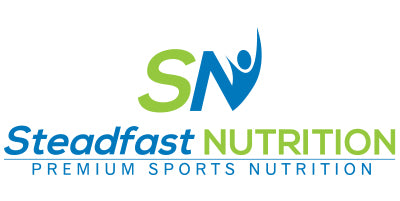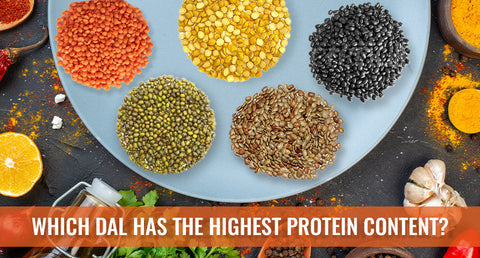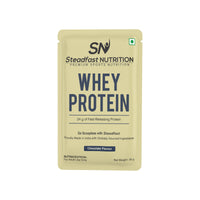Table of Content
Pulses or lentils, commonly known as dal in the Indian subcontinent, are a staple across households. They are a versatile food option that is also extremely easy to cook, and readily available in any market at an affordable cost. They are frequently incorporated in various cuisines, especially in South Asian countries, and are an integral part of Indian diets. A single serving of cooked dal usually provides approximately 6-8 grams of protein per serving but may vary depending on the type of dal and the way it is cooked. For example, 30 g of toor dal serving provides around 6.5 g of protein, whereas moong dal has around 6.7 g per 30 g serving. With so many options available, you might wonder, “Which dal has the highest protein?” Going ahead, we will discuss the significance, role, and health benefits of these protein-rich superfoods.
Why Protein Matters: Essential Role in Your Health
- Protein, as we all know, is the building block of life. It is one of the key macronutrients among the three macronutrients (the other two being fats and carbohydrates) made up of amino acids that are attached with the help of peptide bonds.
- Protein is important for overall growth and development and building & repairing of tissues, improving muscle mass and strength and providing structural support to the body.
- Protein supports overall health by supporting enzymatic reactions that support digestion, energy production and hormonal functions.
- Certain protein types like keratin, collagen and elastin help support the skin and hair health. It also promotes the absorption of nutrients to maintain optimal energy levels throughout the day.
Proteins also support the body in maintaining pH levels and help regulate and maintain body fluid balance. Protein also protects the body from disease-causing pathogens with the help of immunoglobulins and lactoferrin which act as antibodies to fight infections and strengthen immunity.
For those looking for convenient protein options, these high protein dals are your go-to choice as they are loaded with nutrients like potassium, zinc, folate, and iron other than protein. They are also an excellent source of copper and phosphorus, making it a nutritional powerhouse. It also helps individuals on their weight loss journey to help manage weight.
Factors Affecting Protein Composition in Pulses
- Soil condition: The quantity of protein in dal is also dependent on soil quality, like the availability of nutrients such as sulfur, phosphorus and nitrogen in the soil, as these nutrients play a key role in the synthesis of protein.
- Genetic variety: Different types of high protein dals have different genetics and amino acid profiles, resulting in varying levels of protein.
- Water and temperature: Extreme temperatures, either too high or too low, and poor water supply can impact developmental stages and the amount of protein in dal.
- Processing method: Pulses are processed before circulating in the market, including sorting, dehusking, splitting, cleaning, and lastly packing. The pulses’ protein profile may be affected during this stage because nutrients may get destroyed or leach out during the processing method.
Understanding these factors is essential, as it can help you choose and prepare all the available high protein dal or pulses in a way that you get maximum nutritional benefits for optimal health.
Comparative study of protein content in various dals
Approximate protein content in some common high-protein dals per 100 g:
- Bengal gram (Chana dal): It contains ~18.77 g of protein and provides multiple benefits due to the high content of fibre, iron, vitamins and minerals. It also helps improve bone health, supports weight management and manages blood sugar levels.
- Black gram (urad dal): With ~23 g of protein, it improves metabolism and helps improve digestion which means it helps relieve constipation. It also has diuretic properties. Those suffering from high levels of uric acid are advised to avoid its consumption.
- Green gram (Moong dal): It contains ~22 g of protein and antioxidants vitexin and iso-vitexin, which act as an anti-inflammatory and may prevent heat strokes and lower LDL levels (bad cholesterol). It should be avoided by those suffering from kidney or gallbladder problems.
- Horse gram (Kulith/Kulthi/Kollu dal): It has around ~21 g of protein and is rich in important nutrients such as fibre, which can regulate appetite and help maintain blood sugar levels. It also contains iron, phosphorus, and vitamin C, which supports skin health.
-
Red Lentil (Masoor dal): Masoor dal contains approximately ~24gm of protein and is rich in Vitamin A, which helps promote eye and skin health. Red lentils are also packed with potassium, which helps manage blood pressure levels. It is also the highest-protein dal available to include in your daily diet.
How to enhance protein absorption from dal consumption
We have compared and discussed which dal has the highest protein content above. Now, let’s talk about how these dals should be consumed so that the protein content in them can be absorbed adequately by the body to maximise their benefits.
- Combining dals with grains: It is important to get a complete protein profile; hence, one should include grains, millet, and beans along with the dals. As all legumes have different nutritional profiles, it is suggested to include a variety of dals in the daily diet to fulfil the protein and other nutritional needs. To gain a complete protein profile, it is essential to pair them up with rice, roti, or quinoa.
- Include supportive nutrients: Vitamins like pyridoxine (B6) promote the breakdown of protein for digestion and absorption by aiding digestive enzymes. Moreover, vitamin C is also involved in the protein metabolism. Hence, it is crucial to take vitamin C and vitamin B6 while taking protein to increase absorption and digestibility.
- Soak pulses before cooking: Soaking pulses for at least 2-3 hours helps enhance the digestibility of protein. Moreover, this method helps remove anti-nutrients like tannins, which may hinder protein absorption and reduce the chances of flatulence after consumption of high protein dal.
- Including in soups and salads: Dals are a versatile food product that can be used in different kinds of soups and as part of salads. For example, lentil soup with leafy green vegetables and herbs makes a great satiating dish for those trying to incorporate more healthy protein sources into their diets. Rajma and chickpeas can also be made a part of salads to increase the protein content.
- Choose different forms: Choosing different forms of dals like sprouted dals can help increase nutrient availability. Roasted dals like roasted chana also tend to retain more nutrients than boiled dals.
- Reducing the amount of cooking oil: Cooking dals with generous amounts of oil and ghee makes it calorie-laden. It is advised to avoid excess usage of oils to absorb all nutrients and minerals available in dals for maximum benefits. Further, intake of protein along with excess fat may decrease the rate of digestion of protein in dal. That is why, include healthy fats with protein in moderation to avoid the same.
Health Benefits of Dal Beyond Protein
- Improves digestion: The highest protein dals are also loaded with dietary fibre, which helps promote digestive health and good bowel movement. For example, chana dal improves digestion and is also helpful for diabetic patients.
- Prevents iron deficiency: Dals are a rich source of non-heme iron, which helps prevent fatigue and iron deficiency.
- Supports heart health: Lentils also contain fibre and potassium, which support heart health and lower the risk of bad cholesterol.
- Blood Sugar Control: The high fibre content in dals helps manage blood sugar levels.
- Promotes bone health: Some of the highest protein dals such as moong dal (yellow lentils) and masoor dal (red lentils) are a rich source of calcium, phosphorus, and magnesium, which strengthens the bones.
Fulfil your protein requirement with Steadfast Nutrition’s exclusive recovery range!
Dal is an essential source of protein for people across the globe. However, it lacks a few amino acids from all nine amino acids in varieties of pulses. It is crucial to incorporate other protein-rich sources along with reliable dietary protein supplements to fulfil the protein demands. That is when Steadfast Nutrition’s Whey Protein comes into the picture. It is an essential supplement for instant muscle recovery and muscle building, which will help you kickstart your fitness journey. Steadfast’s Whey Protein has low amounts of carbohydrate and fat content, making it the best supplement to improve daily protein intake. It is particularly beneficial for those engaged in regular physical activity like sportspersons and athletes or for those who want to manage their weight.
Conclusion
After going through the protein profiles of various dals in search of the answer to the query “Which dal has the highest protein content,” it can be said that red lentil and black gram contains the highest amount of protein and are a rich source of fibre, potassium, calcium, fibre, and zinc, among various other vitamins and minerals. Yet, there is no consensus on whether high protein dal or pulses are the best plant-based protein sources for vegetarians, vegans, or anyone looking to boost their protein intake. Many argue that dals cannot be classified as a primary protein source since they contain more carbs than protein. Thus, opting for a combination of other food groups such as whole grains, millet, nuts, and seeds in addition to protein supplements. A well-balanced diet with exercise can help you maintain a healthy lifestyle and give you maximum benefits.


